
Transcription
Ind-AS 115- Revenue fromContractwith CustomersC.A. Hemant WaniWIRC- Nov 2019
Fundamentals of taxationMinimum Alternate Tax (MAT)Normal Taxation The financials prepared in accordance with Schedule No Tax on hypothetical income Tax is on real incomeprescribed under Companies Act and approved by No income from selfstatutory auditors, shareholders is final There is no income in absence of accrual Specific provision of the Act /ICDS will overrideadjustments permitted by Section 115JB (Exceptionaccounting treatmentAuditor Qualification) Legal form of transaction will prevail except in case of Judicial precedents dealing with concept of incomediscussed in next slideSpecific provision to capture impact of Ind-ASaccountingsham transaction List of exhaustive /specific downward/ upward Landmark decision- Apollo tyres
Fundamentals of taxationNormal Taxation - Judicial precedentsSri Kikabai Premchand(24 ITR 506), (SC) No one can make profit out of himselfHind Construction (83 ITR 211), (SC) A sale contemplates a seller and a purchaser. Higher revaluation of stock in books does not lead to taxableprofitShoorji Vallabhdas & Co (46 ITR 144), (SC) A mere book-keeping entry cannot be income, unless Income has actuallyresultedE.D.Sasoon & Co (26 ITR 27), (SC) The entries in the books represented only hypothetical income and the amounts in question did not represent the income which hadreally accrued to the assesseTuticorin Alkali Chemicals (227 ITR 172), (SC) Whether a receipt of money is taxable or not, the question has to be decided according to the principles of law and not in accordancewith accountancy practice does not determine taxability”
Sale of Goods as per ICDS IV In a transaction involving the sale of goods, the revenue shall be recognised when the seller of goods has transferred to the buyer theproperty in the goods for a price or all significant risks and rewards of ownership have been transferred to the buyer and the sellerretains no effective control of the goods transferred to a degree usually associated with ownership. In a situation, where transfer ofproperty in goods does not coincide with the transfer of significant risks and rewards of ownership, revenue in such a situation shallbe recognised at the time of transfer of significant risks and rewards of ownership to the buyer. Revenue shall be recognised when there is reasonable certainty of its ultimate collection. Where the ability to assess the ultimate collection with reasonable certainty is lacking at the time of raising any claim for escalation ofprice and export incentives, revenue recognition in respect of such claim shall be postponed to the extent of uncertainty involved.
Rendering of Services as per ICDS IV Subject to Para 7, revenue from service transactions shall be recognised by the percentage completion method. Under this method,revenue from service transactions is matched with the service transaction costs incurred in reaching the stage of completion,resulting in the determination of revenue, expenses and profit which can be attributed to the proportion of work completed. IncomeComputation and Disclosure Standard on construction contract also requires the recognition of revenue on this basis. Therequirements of that Standard shall mutatis mutandis apply to the recognition of revenue and the associated expenses for a servicetransaction. However, when services are provided by an indeterminate number of acts over a specific period of time, revenue may berecognised on a straight line basis over the specific period. Revenue from service contracts with duration of not more than ninety days may be recognised when the rendering of services underthat contract is completed or substantially completed.
Introduction to Ind-AS 115 The Ministry of Corporate Affairs (MCA) has notified the new revenue recognition standard – Ind-AS 115 which replaces existing IndAS 11 (Construction contract) and Ind-AS 18 (Revenue recognition) Ind-AS 115 is applicable from 1st April 2018 i.e. FY 2018-19 The core principle of Ind-AS 115 is that revenue needs to be recognized when the entity transfers control of goods and services tocustomers at an amount that entity expects to be entitledInd-AS 18Ind-AS 115Transfer of Risk andRewardTransfer of Control More guidance on separating goods and services bundled in a contract More guidance on measuring transaction price Replace certain Guidance Notes (e.g.: Real Estate Revenue Recognition) Ind-AS 115 is based on the five step model
Introduction to Ind-AS 115The Five Step Model1- Identify contract with the customer2- Identify the performance obligations in the contract3- Determine the transaction price4- Allocate the transaction price to the performance obligations in the contract5- Recognise revenue when (or as ) the entity satisfies a performance obligation
Identifying the Contract Parties approve the contract in writing / oral etc and are committed; Each parties rights and payments terms are identified; There is a commercial substance and it is probable that the entity shall receive the consideration for transfer of goods and services.Revenue recognition in case of:-Unilateral enforceable rights to terminate a wholly unperformed contract without compensation;-No criteria met under the contract but the entity receives consideration: Entity has no remaining obligations to transfer goods or services to the customer and all orsubstantially all consideration has been received by the entity and is non refundable; The contract is terminated and the consideration received from the customer is nonrefundable.
Non refundable upfront fee The company obtains non refundable deposits for new dealership These deposits are recorded as Income immediately on receipt whenever an agreement is signed under existingIGAAP The upfront one-time set up fee paid shall be recognized over the period of contract rather than recognizing the same upfront atcontract inception ICDS is silent on non refundable upfront fee received from customers As per the existing practice, upfront fee is taxed immediately on receiptbasisThe current tax practice of offering non-refundable upfront fee immediately onreceipt can be continued under ICDS if the conclusion is that of signing ofagreement and granting of dealership is the consideration for charging of thenon-refundable fee
Contract ModificationsAn entity shall account for a contract modification as a separate contract if: The scope of the contract increases because of the addition of promised goods or services which are distinct The price of the contract increases by an amount of consideration that reflects the entity’s stand-alone selling price of the additionalpromised goods or services and any appropriate adjustments to that price to reflect the circumstances of the particular contract Contract modifications should be accounted prospectively If the entity does not account for contract modification as a separate contract then the accounting approach to account for terminationof existing contract and creation of new contract if the remaining goods and services transferred are distinct. Else if the goods andservices are not distinct then the same could be accounted as part of existing contract.Illustration: Entity AB Ltd enters into a three-year service contract with a customer CD Ltd for Rs. 4,50,000 (Rs. 1,50,000 per year). At the beginning of the third year, the parties agree to modify the contract as follows: (i) the fee for the third year is reduced to Rs. 1,20,000 and (ii) CD Ltd agrees to extent the contract for another three years for Rs. 3,00,000 (Rs. 1,00,000 per year) In the given case, modification shall be accounted as if the existing arrangement was terminated and a new contract was createdbecause the remaining services to be provided are distinct.At the end of 3rd Year: As per Ind-AS 115 AB Ltd shall reallocate the remaining consideration to all the remaining services to be provided, a total of Rs4,20,000 (Rs 1,20,000 Rs 3,00,000) i.e. the obligations remaining from the original contract and the new obligations over theremaining four- year service period. As per AS- 9, AB Ltd shall recognize Rs. 1,20,000 as revenue for the 3rd year onwards.
Contract Modifications Revenue from Operations from 3rd Year onwards are as under:(Rs in ‘000’)Extract of Profit & Loss account as per ue120100100100Other Expenses80808080Net Profit40202020(Rs in ‘000’)Extract of Profit & Loss account as per Ind-AS 05105105105Other Expenses80808080Net Profit25252525
Multiple Performance Obligations Performance obligation is satisfied over a period of time or at a point of time. It is satisfied over a period of time if one of thefollowing criteria is met:the customer simultaneously receives and consumes the benefits provided by the entity’sperformance as the entity performs;the entity’s performance creates or enhances an asset that the customer controlsorthe entity’s performance does not creates an asset with an alternative use to the entity and theentity has an enforceable right to payment for performance completed to date. Entity A enters into a contract with Customer B to manufacture and install machine for Rs. 8,00,000 as at March 2018 The standalone value of the product is Rs. 7,00,000 and standard installation is Rs. 2,00,000 The installation is completed by June 2018PotentialPerformanceobligationsPotential PerformanceObligationMachineInstallation
Multiple Performance Obligations In the given case, company offers these services in combination and the customer cannot benefit from the installation services on itsown or together with other readily available resources, i.e. only company A can install the machine because of its complicatednature, then there is only one performance obligation The machine cannot be used before installation and the customer cannot obtain the benefits of using the product before installation,i.e. money received will have to refunded unless the installation is successful Ind-AS 115 recognizes revenue from sale of goods when the control of goods has passed to the customer and control includes theability to prevent other entities from directing the use or obtaining the benefit from anasset In the given case, company offers these services in combination and the customer cannot benefit from the installation services on itsown or together with other readily available resources, i.e. only company A can install the machine because of its complicatednature, then there is only one performance obligation The machine cannot be used before installation and the customer cannot obtain the benefits of using the product before installation,i.e. money received will have to refunded unless the installation is successful Ind-AS 115 recognizes revenue from sale of goods when the control of goods has passed to the customer and control includes theability to prevent other entities from directing the use or obtaining the benefit from anassetIn such cases, revenue of Rs. 8,00,000 will be recognized when installation is complete, i.e. June 2018 and notwhen the risk, reward and ownership has been transferred i.e. March 2018 as per IGAAP.
Significance of Turnover - Step – 3 - Determination of Transaction PriceVariable consideration and theconstraint- Expected value andthe most likely amountConsideration payable to a customer.Reduction in transaction price unlessit’s a payment for a distinct good orservice.TRANSACTION PRICENon-Cash ConsiderationMeasured at fair value unless itcannot be reliably measured.Significant financing component
Significance of Turnover The base for computing the amount of gross receipts or turnover of business will be different under Ind-AS 115 as compared toearlier Ind-AS, IGAAP, thereby impacting applicability of some provision of Income Tax Act which are linked to quantum of “sales”,“gross receipts” or “turnover” of the business (for e.g.: Section 47(xiiib), section 44AB). Some examples of accounting change under Ind-AS are as follows: In case of customer rewards programs, the fair value of reward points is reduced from transaction value and is recognized asrevenue as and when the points are redeemed by customer If there is an exception that some goods sold will be returned by the customer at a later date, under Ind-AS, revenue is adjusted forvalue of expected returns Revenue recognition rules are required to be applied independently qua each separate identifiable component. For example, if acar is sold with extended warranty, the warranty element embedded in the selling price is required to be recognized separately asrevenue over the extended period.
Recognition of revenue as and when performance obligation is satisfiedAn entity transfers control of a good or service over time and thereforesatisfies a performance obligation and recognises revenue over timeIllustration: An operator offers a subscriber 1000 call minutes @ 10p per minutefor the March 2018 with the option of rolling over unused minutes tothe following month Extract of I-GAAP Profit & Loss AccountExpenses The operator has a history of enforcing expiry dates The subscriber shall use 700 minutes for March 2018 and 300minutes shall be rolled over to the following months i.e. April andMay 2018 Revenue is recognized in the accounting period in which the20 0Extract of Ind-AS Profit & Loss AccountExpensesAmountIncomeOtherexpenses20 RevenueNet Profit50March’18May’183070Extract of Ind-AS Balance sheet as on 31 March 2018services are rendered, which in this case would be when theLiabilitycontracted call minutes are provided i.e., the allocation is toProvision forunused minutesminutes and not periodsIncomeOtherexpenseThe subscriber can use the unused minutes for the following 2months, after which they expire.AmountAmount30 The operator recognizes revenue when the minutes are used andany unused minutes at the end of each month as contract liability28AssetAmount
Discount and Rebate Under Ind-AS, revenue should be recognized at fair value of the consideration receivable net of discounts and rebates when it isprobable that such discounts will be granted and the amount can be measuredreliably. ABC Ltd offers certain cash discounts to customers for early settlements. Therefore, the estimate of cash discounts that would begiven to the customers would also be deducted from revenue under Ind-AS. The definition of revenue under ICDS is similar to definition of revenue under AS 9 Recognizing expected cash discount (not actually provided) as a reduction from revenue may not meet the requirement under ICDS.Therefore, such cash discounts would not be deductible from revenue for tax purposes. But the same would be allowed as anexpense when actually incurred.
Sales with a Right toreturn Rights of return is a form of variable consideration Revenue recognition is limited to amounts for which it is “highly probable” a significant reversal will not occur, i.e. the goods shallnot be returned In some contracts, an entity transfers control of a product to a customer with an unconditional right of return Illustration: A Ltd, a manufacturer of garments sells garments @ Rs. 1000 The gross margin that it would earn per garment is Rs. 100 Full amount is refunded to retailers provided garments are undamaged A Ltd is expecting that 5% of the goods sold during the year will be refunded in next financial year As per IGAAP, A Ltd shall recognize full consideration since risk, reward and ownership has been transferred and simultaneouslyshall provide for Provision for sales return However, as per Ind-AS 115, A Ltd shall recognize revenue only to the extent it expects to be entitled i.e. Rs. 950/- andsimultaneously shall also recognize a refund liability for the balance5%
Sales with a Right toreturnI-GAAPInd-AS 115Extract of Profit & Loss Account for FY 2018-19Extract of Profit & Loss Account for FY 2018-19ExpensesOther expensesProvision for salesreturnsNet profitAmountIncome700 SalesAmountExpenses1,000Other expensesNet profitExtract of Balance sheet as on 31 March 2019Provision for salesreturnIncome700* Extract of Balance sheet as on 31 March 2019AmountLiabilityProvision for refundliabilityAmountAsset50 Goods to be returnedAmount50*Corresponding adjustment to cost of sales is recordedfor items expected to be returned.The impact of accounting of right to return on provision may get disallowed for the purpose of tax computation since ICDS is silent ontax treatment of provision for sales return.As per ICDS revenue is requires to be recognition on transfer of significant risksand rewards to the customer.
Deferred payment terms / Financing AgreementInd-AS 115 requires revenue to be measured based on fair value of sale consideration received or receivable. If the arrangementeffectively constitutes a financing transaction, Ind-AS 115 requires that entity shall determine the fair value of the consideration bydiscounting all future receipts using an imputed rate of interest.Sale priceRs. 1,00,000Sell pricepayable aftertwo yearsIllustration Entity X has entered into a contract to sell a television to acustomer for a consideration of Rs. 1,00,000. The payment for the equipment is to be made after 2 years. The cash selling price of the product is Rs. 80,000 whichrepresents the amount that customer would pay upon deliveryCash price of theproduct – Rs.80,000InterestComponent – Rs.20,000for the same product sold under otherwise identical terms andconditions as at contract inception. Contract includes a significant financing component and this isevident from the difference between the amount of promisedconsideration of Rs. 1,00,000 and the cash selling price of NRAn entity shall consider all relevant facts andcircumstances in assessing whether a contractcontains a financing component and whether thatfinancing component is significant to the contract80,000 at the date when the television is transferred to thecustomer
Deferred payment terms / Financing AgreementThe revenue to be recognized under Ind-AS 115 and its tax implications shall be as under: An entity shall present the effect of financing, i.e. interest revenue separately from revenue from contracts with customers in thestatement of Profit and loss Accordingly, Entity X will recognize revenue with a corresponding receivable equal to the cash selling price of Rs. 80,000 and theinterest revenue shall be recognized in accordance with Ind-AS109.ICDS IV dealing with revenue recognition defines revenue as “gross inflow of cash, receivables or other considerationarising in the ordinary course of business from the sale of goods, rendering of services”ICDS III also provides that contract revenue shall comprise of variations in contract work, claims and incentivepaymentsMeasurement based on Ind-AS should not considered for “Normal Tax” purpose
Recognition of revenue in case of redemption of Bonus/ Loyalty points If in a contract, an entity grants a customer the option to acquire additional goods or services, that option gives right to a separateperformance obligation only if the option provides a material right to the customer that it would not receive without entering intothat contract The customer in effect pays the entity in advance for future goods and the entity recognises revenue when the goods are transferred Accordingly, an entity shall account for bonus points as a separate performance obligation of the sales transactions in which they areinitially granted Illustration A Ltd, owner of a resort under the scheme grants 1 point for every Rs. 100 spent for stay in theresort As per the past experience, the likelihood of exercising of the points is 100% The stand-alone price of each point is Rs. 5 Customer X spends Rs. 10,000 in one of the resorts and earns 100 points Revenue recognized under IGAAP and Ind-AS 115 shall be as under: Under I-GAAP, there is no guidance covering the situation of bonus points. Generally full amount of consideration includingthe bonus is considered in year 1 itself, as all the significant risk and rewards have beentransferred Under Ind-AS 115, A Ltd shall split the amount of consideration into revenue from customers at fair value i.e.(10000/10500*10000) and revenue from bonus points at fair value i.e. (500/10500*10000)
Recognition of revenue in case of redemption of Bonus/ Loyalty pointsI-GAAPInd-AS 115Extract of Profit & Loss Account for FY 2018-19Extract of Profit & Loss Account for FY 2018-19ExpensesAmountOther expensesXXProvision for bonuspoints500Net profitXXXIncomeSalesAmountExpenses10,000Other expensesNet profitExtract of Balance sheet as on 31 March 2019LiabilityAmountProvision for act of Balance sheet as on 31 March 2019AmountLiabilityDeferred revenueDeductibility of provision needs to be separately evaluatedunder ICDS – 10AmountAssetAmount476Rs. 476 shall be recognized in the year of redemption or onexpiry of such points if the bonus points are not redeemed.ICDS is silent on the treatment for customer loyalty pointsProvisions of ICDS - IV is in line with AS 9 and whether reducing revenue upfront on account of loyalty point needs to be evaluated
Recognition in case of non-cash incentives Ind-AS 115 requires that revenue from sale of goods orservices shall be recognized when the entity satisfies aperformance obligation by transferring the promised good orservices to a customerExtract of P&L account as per I-GAAP - FY 2018-19ExpensesNet profit Illustration: Free goods or services are provided by a selleron purchase of 2 products, i.e. on purchase of two products,third product is freeNet profitAmount200XXXExtract of P&L account as per Ind-AS 115 - FY 2018-19ExpensesAmountIncomeAmountSales [200*2/3]133XXXExtract of P&L account as per I-GAAP - FY 2019-20ExpensesAmountIncomeAmountSalesNet profitResults in postponement of revenue. Similar situationnot covered under ICDS, timing of recognition of revenuefrom tax perspectiveIncomeSales Further, Ind-AS 115 provides that, at the contract inception, anentity shall assess the goods or services promised in thecontract with the customer and shall identify each promiseas a performance obligation to transfer a good or servicethat is distinct and separately identifiable to the customer If, the third product is provided in the next year, the revenuerecognized for sale of goods or services under Ind-AS 115 is:AmountNilXXXExtract of P&L account as per Ind-AS 115 - FY 2019-20ExpensesNet profitAmountXXXIncomeAmountSales [200*1/3]67
Comparison between Ind AS 115 viz-a-viz ICDSParticularsInd-AS 115ICDSRevenue recognition principleFor goods, revenue is recognised ontransfer of risk and rewards. For services,Revenue is recognised based on five step model revenue is recognised to the extent ofon transfer of control to customerstage of completion of contractDetail requirements apply for identifying andrecognising revenue on multiple-element Do not require or prohibit identification ofperformance obligation.Identification of performance obligation contractsAllocation of transaction priceAllocated to performance obligation identifiedbased on relative standalone selling price.Not covered in ICDSVariable considerationCurrently,entitiesmaydefermeasurement of variable considerationuntil uncertainty is removed. For e.g.Methodology for estimating and recognizing claims in construction contracts arevariable consideration provded.recognised on final certainty.Sales returnRevenue is recognised after deducting estimatedreturn. Sales returns result in variableNo guidance is provided in ICDSconsideration.Significant financingRevenue is adjusted for significant financing and Revenue is not adjusted for time value ofpresented separately as finance cost/incomemoney
Comparison between Ind AS 115 viz-a-viz ICDSParticularsInd-AS 115ICDSNon-cash considerationMeasured at fair valueNo guidance providedOnerous contractExpected losses are recognised as an expense Losses incurred on a contract will be allowed only inimmediately.proportion to the stage of completionReal estate revenueIf the entity has a right to receive payment for workcompleted to date, POCM is applied. Else completedExposure draft issued. Requires POCM.contract method needs to be followed.Reasonable certainty threshold of 25% is specified.Early stage contractRevenue is recognised to the extent of costsRevenue recognized to the extent of cost if there is incurred when up to 25% of the work is completedno reasonable certainty.otherwise proportionate method will apply.POCM applied. Straight-line method, if servicecontract involves indeterminate number of acts overspecific period of time.Completed contract, if duration 90 daysService contractRevenue is recognized on transfer of control.Retention moneyRetention monies are a deduction from the revenuebill, which is paid by the customer on satisfactorycompletion of contract or warranty period. Theretention monies are treated as normal revenue.Same as Ind AS. Retention is part of overall cont
Transition to Ind-AS 115 Any impact of transition to Ind-AS 115 needs to be given in opening retained earnings as on 1st April 2018 Following are the alternative approaches that the entity may adopt for transitioning to Ind-AS115 The entity would compare the revenue recognized as per Ind-AS 18 / Ind-AS 11 / IGAAP / Guidance Note for each arrangement, inrespect of open contracts as on 31st March 2018, with amount that would have been recognized as per Ind-AS115 The difference between these two amounts would be accounted as a cumulative catch-up adjustment and would be recognizedon 1st April 2018 in the opening retained earningsRevenue as perInd-AS 115 Revenue as perInd-AS 18 / IndAS 11 / IGAAP/Guidance NoteDifference to berecognized in“Opening RetainedEarnings”Option I of Transition - Full Retrospective Approach Recasting comparatives of FY 2017-18 (presentation perspective) – 1st April 2017 Accounting entries to be passed on 1st April 2018 Option II of Transition - Cumulative effect Approach No recasting comparatives of FY 2017-18 Disclosure of quantitative effect of Ind-AS 115 Accounting entries will be passed on 1st April 2018
Transition requirement while adopting Ind-AS 115 – Il ustration - Tax ImplicationsIllustration I: A Ltd has adopted Ind-AS prior to 1 April 2018 A Ltd, as on 1 April 2018 has existing contracts of software license, professional services and post-delivery support service for Rs.50,00,000 which were accounted for previously under Ind-AS 18 A Ltd has recognized entire revenue of Rs.50,00,000, A Ltd treated the development of software and post-delivery support service as a“single performance obligation” However, had A Ltd adopted Ind-AS 115, it would have identified three performance obligations (Software License, ProfessionalService. Post delivery Service A Ltd would need to allocate the estimated transaction price based on relative stand-alone selling price (or any other appropriatemethod) to the newly identified distinct performance obligationsPerformanceobligationInd-AS - 18Revenue FY 17-18Ind-AS - 115Revenue FY 17-18Software License 40,00,000 40,00,000Professional Service 8,00,000 8,00,000Post delivery Service 2,00,000XTotal50,00,00048,00,000
Transition requirement while adopting Ind-AS 115 – Il ustration - Tax Implications A Ltd would compare the revenue recognized as per Ind-AS 18 for each arrangement, in respect of open contracts as on 31st March2018, with amount that would have been recognized as per Ind-AS 115 A Ltd records an adjustment to opening retained earnings on 1st April 2018 to reflect the difference between revenue alreadyrecognized under Ind-AS 18 and the revenue that would have been recognized under Ind-AS 115 as on that date The difference between these two amounts would be accounted as a cumulative catch-up adjustment and would be recognized on 1stApril 2018 in the opening retained earningsParticularsApril 1, 2018Revenue under Ind-AS 18Rs. 50,00,000Revenue under Ind-AS 115Rs. 48,00,000 [40,00,000 8,00,000)Adjustments in Opening Retained Earnings (Debit)Rs. 2,00,000
Transition requirement while adopting Ind-AS 115 – Il ustration - Tax Implications Issue— A Ltd had offered the entire amount of Rs. 50,00,000 to tax till FY 2017-18 under the normal provisions of the Act as well as underthe MAT provisions— On account of introduction of Ind-AS 115, the amount of such revenue offered to tax in preceding years, would again be creditedto P&L account of FY 2018-19 (assuming performance obligation is met in FY 2018-19) by corresponding adjustment to retainedearnings as on 31 March 2018— Whether the amount of Rs. 2,00,000 credited to Profit & Loss account of FY 2018-19 as per Ind-AS 115, shall be liableto MAT?— Whether A Ltd will be able to claim the adjustment to opening reserves as part of the transition amount over a period of 5 years? As per explanation to sub-section 2(c) of section 115JB of the Income-tax Act, 1961 (‘the Act’) transition amount computed as on theconvergence date shall be adjusted to the book profits of the Company for the purposes of MAT Convergence date means the first day of the first Ind-AS reporting period as defined in Ind-AS 101
Transition requirement while adopting Ind-AS 115 – Il ustration - Tax Implications Whether “First Ind-AS reporting period” under Ind-AS 101 (First time Adoption of Indian Accounting Standards) is to be determinedevery time a newly notified Ind-AS is adopted or whether the same is only to be determined in the financial year in which thetransition from I-GAAP to Ind-AS occurs A Ltd has adopted Ind-AS prior to FY 2018-19, pursuant to notification of new Ind-AS 115 effective (from 1 April 2018), A Ltd. will apply
AS 11 (Construction contract) and Ind-AS 18 (Revenue recognition) Ind-AS 115 is applicable from 1. st . April 2018 i.e. FY 2018-19 The core principle of Ind- AS 115 is that revenue needs to be recognized when the entity transfers control of goods and services to customers at an amount that entity expects to beentitled










